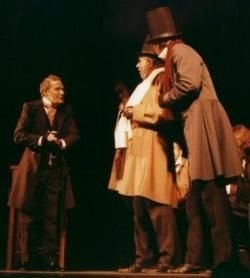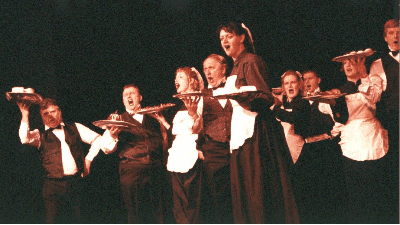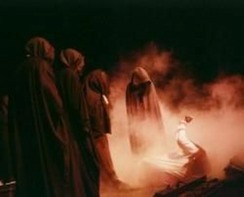![]()

Someone (I think it may have been me) once compared putting on a show to making a model aeroplane: you never know until you launch it into the air whether it's going to fly or not. Of course, if you stick to a model made from a kit of parts, and follow the instructions, then you can be pretty sure that you will end up with a successful result. The same principle seems to apply to shows: if you pick one of the well-tried box-office favourites, you can be fairly confident that if you follow the instructions in the libretto, you will end up with a successful show.
At the risk of stretching the analogy, what happens when you get fed up with pre-cut kits? When an out-of-the-box model becomes basically unsatisfying because (dare I say it?) it's too easy to do? In the model aeroplane world, there is an alternative - you can buy a plan - a blueprint that shows you how the model fits together, but with no help as to how to make it, no advice on what materials to use - in fact, nothing at all. I remember being so bold as to try this next stage of model making, and the gulf between the pre-cut version and this unhelpful (and very large) plan was vast. It took me months of studying the plan before I had the nerve to buy my first strip of balsa wood.
But what has this preamble got to do with A Savoy Christmas Carol? I have a confession to make: some time ago I found myself getting a little complacent about the shows I found myself in. In particular, the limited number of Gilbert and Sulivan shows was starting to prove an obstacle to the group I was with. What to do after you've done all the favourites? Of course there are the lesser known G&S works, and there's Offenbach - but what else? I realised that the G&S canon is far too small for the vast number of people who love it so much. So, I decided to take the plunge and move from the pre-packed version of a G&S show to create a 'blueprint only' version of my own.
As my blueprint, I took Charles Dickens' novel, A Christmas Carol, and as my source of material, the music of Arthur Sullivan and the words of W S Gilbert. Like the aeroplane, I spent months pouring over the original novel, trying to decide where to start, and which section to pick up and try to assemble first. Whoever said that all creative activity is one percent inspiration and ninety-nine percent perspiration never spoke a truer word. No sooner than I had a glimmer of an idea, than I disappeared under a mound of music and words, trying desperately to decide what would fit best to the mood I was trying to create, the characters I had in mind.
Altogether it took three years to put the whole thing together; three years during which I had no idea whether the show would fly, or whether it would nose-dive ignominiously. Fortunately, I was lucky enough to have a group of talented performers who were open to a challenge, and I was able to persuade the Concept Players that it would be a positive contribution to their development as a group to put on this unusual mixture of Dickens, Gilbert, Sullivan - and me.
I have to admit that I underestimated the effect of such a challenge on the group. Even with the strong cast we put together, it took far longer than we anticipated. I had intentionally introduced far more music for the chorus than might normally be expected, but I knew that the Concept Players excel at choral singing, and that they would rise to the challenge. Add to this, the technical complexities I built in - offstage chorus singing, voices out of the darkness via the PA system, sophisticated lighting effects co-ordinated with the music, innumerable costume changes and so on - and you have a recipe for potential disaster!
At the end, everything eventually slotted into place, and the final effect was - well, not as I had originally imagined it, but what author ever fully realises the image in his head?

Was it a success? Artistically, I have to say a resounding yes - as a show it works brilliantly. Audiences loved it. The cast loved it (in spite of their complaint that it was the hardest show they had ever done). Even the most dyed-in-the-wool G&S enthusiasts loved it: I lost count of the number of people who came to tell me how surprised and delighted they were that the words and music fitted so well with the mood and spirit of Dickens' classic. One of the things that became clear was that by returning to the original spirit of the piece, we attracted people who would otherwise not have come to see us. Who knows whether a mood of nostalgia was there to be captured at the end of the Millennium, a harking back to simpler, less stressful times? But I do know that we should have sold paper handkerchiefs in the interval - we would have made a fortune!

Would I do it again? For three years, this project ran my life in one way or another, and of course I miss it. But I would do it again - and not necessarily as an act of masochism! Although there have been many previous versions of A Christmas Carol, and there will undoubtedly be many more, it gives me enormous satisfaction to know that there is a talented group of people who will never forget their one chance to take part in an original work which no-one had ever performed before. I can't thank them enough for their courage, support and faith, and for their hard work in bringing the whole thing to life.
When I wrote this version of A Savoy Christmas Carol, my intention all along was to create something that would add to the available works which could be tackled by the typical G&S society. I sincerely hope that I have succeeded in doing this, and that there are others out there brave enough to take up the challenge of this adaptation.
Nigel Holloway
The review by Frank Wooles in the NODA Review commented:
'This is great theatre - it works well, and has proved a successful venture. The Concept Players, and in particular Nigel Holloway, are to be congratulated on their enterprise and courage in bringing this attractive adaptation to the stage.'